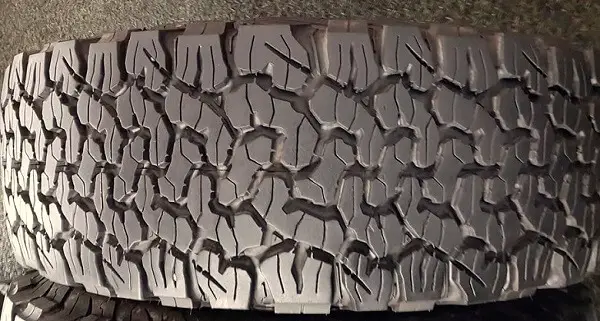Tire Size 265/60r20 vs 275/65r20

The main difference between the tire sizes 265/60r20 and 275/65r20 is that the 275/65r20 is slightly larger in overall diameter, width, and circumference. This results in some key differences in performance, capabilities, and aesthetics.
275/65r20 vs 265/60r20
Discover the differences between the popular tire sizes 265/60r20 and 275/65r20 with our comprehensive comparison table
| 265/60R20 | 275/65R20 | Difference |
|---|---|---|
| Tire Height 32.52″ | Tire Height 34.07″ | 1.56 inch |
| Tread Width 10.43″ | Tread Width 10.83″ | 0.39 inch |
| Sidewall Height 6.26″ | Sidewall Height 7.04″ | 0.78 inch |
| Circumference 102.16″ | Circumference 107.05″ | 4.89 inch |
| Revs Per Mile 620 | Revs Per Mile 591 | -28.3 Mile |
| Speedometer Reading 20 mph | Speedometer Reading 20.96 mph | 0.96 mph |
| Rim Size 20 inch | Rim Size 20 inch | No Difference |
Fitment Guide
When replacing tires, it’s crucial to stay within 3% of the original tire’s overall diameter to avoid clearance issues or errors in speedometer readings. The 275/65r20 exceeds the 3% limit compared to the 265/60r20, with a 4.8% larger diameter.
This means installing 275/65r20 tires on a vehicle originally fitted with 265/60r20 would likely require adaptations like a lift kit to prevent rubbing.

Ground Clearance
With a diameter 1.56 inches larger, the 275/65r20 tire size provides increased ground clearance compared to the 265/60r20.
This added clearance is beneficial for off-road driving, helping prevent scrapes over rough terrain. However, it also causes a lower speedometer reading by around 5%.
Gas Mileage
The slightly smaller 265/60r20 tire has less rotational mass and a smaller contact patch, which could provide marginally better fuel efficiency. The larger 275/65r20 may detract from fuel economy due to more rolling resistance and weight.
Ride Comfort
While the 265/60r20 offers a smooth highway ride, the taller sidewall and increased air volume of the 275/65r20 provide superior impact absorption. This cushions the ride over uneven city streets or rugged off-road terrain.
Aesthetics
Visually, the difference between these two sizes is subtle. The 275/65r20 will have a slightly taller sidewall, giving it a mildly “stretched” look compared to the 265/60r20.
This aesthetic suits some trucks and SUVs better than an overly low-profile appearance.

Handling & Stability
The shorter sidewall and smaller diameter of the 265/60r20 provide sharper handling and quicker response on pavement.
However, the 275/65r20’s additional sidewall flex improves stability on loose or uneven surfaces.
Noise & Vibration
With its stiff sidewall, the 265/60r20 transmits more road noise and vibration into the cabin. The taller 275/65r20 better dampens noise thanks to more sidewall flex, creating a quieter ride.
Durability & Wear
The smaller 265/60r20 may exhibit more even treadwear and longer life. The larger 275/65r20 withstands more abuse, but its added weight could increase wear on suspension components.

Adverse Conditions
The narrower 265/60r20 can cut through to the pavement more effectively in rain or snow. But the 275/65r20’s extra ground clearance is advantageous in deep snow or off-road conditions. Both handle adverse conditions well overall.
Speedometer Reading
At a true vehicle speed of 20 mph, the speedometer reads 20.96 mph with 275/65r20 tires equipped versus 20 mph with 265/60r20 tires. This 0.96 mph speedometer difference results from the larger overall diameter of the 275/65r20 tire.
Alternative of 265/60r20
The presented table provides the tire size for different models as well as the percentage difference in overall diameter compared to a reference tire.
| Tire Size | Overall Diameter | Difference |
|---|---|---|
| 245/60R20 | 31.6″ (802 mm) | -2.9% |
| 295/50R20 | 31.7″ (804 mm) | -2.7% |
| 275/55R20 | 31.9″ (810 mm) | -1.9% |
| 305/50R20 | 32″ (814 mm) | -1.5% |
| 255/60R20 | 32″ (814 mm) | -1.5% |
| 285/55R20 | 32.4″ (822 mm) | -0.5% |
| 315/50R20 | 32.4″ (824 mm) | -0.2% |
| 295/55R20 | 32.8″ (832 mm) | 0.7% |
| 325/50R20 | 32.8″ (834 mm) | 1% |
| 275/60R20 | 33″ (838 mm) | 1.5% |
| 305/55R20 | 33.2″ (844 mm) | 2.2% |
| 375/45R20 | 33.3″ (846 mm) | 2.4% |
| 285/60R20 | 33.5″ (850 mm) | 2.9% |
Alternative of 275/65r20
The table shows the tire size, overall diameter in inches and millimeters, and the percentage difference in overall diameter compared to a reference tire.
| Tire Size | Overall Diameter | Difference |
|---|---|---|
| 305/55R20 | 33.2″ (844 mm) | -2.5% |
| 375/45R20 | 33.3″ (846 mm) | -2.3% |
| 285/60R20 | 33.5″ (850 mm) | -1.8% |
| 295/60R20 | 33.9″ (862 mm) | -0.5% |
| 355/50R20 | 34″ (864 mm) | -0.2% |
| 305/60R20 | 34.4″ (874 mm) | 0.9% |
| 335/55R20 | 34.5″ (876 mm) | 1.2% |
| 285/65R20 | 34.6″ (878 mm) | 1.4% |
| 315/60R20 | 34.9″ (886 mm) | 2.3% |
Our Observation
The 265/60R20 is best suited for vehicles focused on responsive on-road handling and fuel efficiency. Its shorter sidewall and smaller diameter optimize road feedback and tread life.
The 275/65R20 is ideal for off-road adventures and absorbing rough roads. Its added diameter improves ground clearance, while the taller sidewall enhances comfort.
Overall, we recommend the 275/65R20 for most drivers seeking a balance of capabilities. Its modest off-road and comfort advantages make it versatile, while the speedometer error is minimal.

Meet Caitlin McCormack, a Tire Size Expert and Blogger Passionate About Everything Related to Tires. With Years of Experience in the Tire Industry, Caitlin Has Become an Expert in Tire Sizes and Their Impact on Vehicle Performance.
